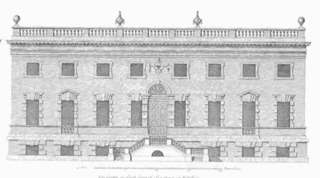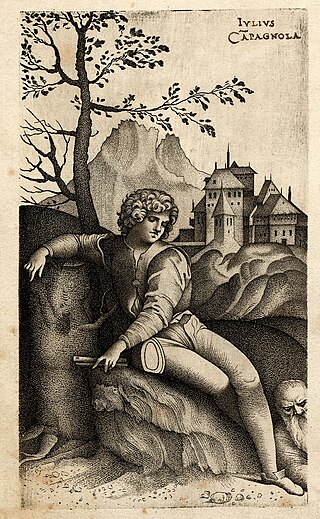
Cambridge Terrace is a row of consecutive terraced mansions overlooking Regent's Park in the London Borough of Camden, London, England. The terrace has been Grade I listed since 1974. [1]

Cambridge Terrace is a row of consecutive terraced mansions overlooking Regent's Park in the London Borough of Camden, London, England. The terrace has been Grade I listed since 1974. [1]
The terrace was designed by John Nash, and completed in 1825. [1] It is named after Prince Adolphus, Duke of Cambridge, the viceroy of Hanover. It is smaller in every respect than its neighbour of Chester Terrace. The centre, and the two wings are distinguished by porticoes of the Roman order or pseudo-Doric order, with rusticated columns. The superstructure, above the porticoes, which are of the height only of the ground story, is plain. [2]
A renewable energy heating and cooling system which burns no fuel on site is being installed in Cambridge Terrace in 2015. [3]

In art, chiaroscuro is the use of strong contrasts between light and dark, usually bold contrasts affecting a whole composition. It is also a technical term used by artists and art historians for the use of contrasts of light to achieve a sense of volume in modelling three-dimensional objects and figures. Similar effects in cinema, and black and white and low-key photography, are also called chiaroscuro. Taken to its extreme, the use of shadow and contrast to focus strongly on the subject of a painting is called tenebrism.

Colen Campbell was a pioneering Scottish architect and architectural writer who played an important part in the development of the Georgian style. For most of his career, he resided in Italy and England. As well as his architectural designs, he is known for Vitruvius Britannicus, three volumes of high-quality engravings showing the great houses of the time.

Wood engraving is a printmaking technique, in which an artist works an image into a block of wood. Functionally a variety of woodcut, it uses relief printing, where the artist applies ink to the face of the block and prints using relatively low pressure. By contrast, ordinary engraving, like etching, uses a metal plate for the matrix, and is printed by the intaglio method, where the ink fills the valleys, the removed areas. As a result, the blocks for wood engravings deteriorate less quickly than the copper plates of engravings, and have a distinctive white-on-black character.

James Elmes was an English architect, civil engineer, and writer on the arts.

Thomas Hosmer Shepherd was a British topographical watercolour artist well known for his architectural paintings.

William Miller was a Scottish Quaker line engraver and watercolourist from Edinburgh.

The Surrey Theatre, London began life in 1782 as the Royal Circus and Equestrian Philharmonic Academy, one of the many circuses that provided entertainment of both horsemanship and drama (hippodrama). It stood in Blackfriars Road, near the junction with Westminster Bridge Road, just south of the River Thames in what is now the London Borough of Southwark.

Giulio Campagnola was an Italian engraver and painter, whose few, rare, prints translated the rich Venetian Renaissance style of oil paintings of Giorgione and the early Titian into the medium of engraving; to further his exercises in gradations of tone, he also invented the stipple technique, where multitudes of tiny dots or dashes allow smooth graduations of tone in the essentially linear technique of engraving; variations on this discovery were to be of huge importance in future printmaking. He was the adoptive father of the artist Domenico Campagnola.

William Tombleson was an English topographical and architecture artist, illustrator, copper and steel engraver, writer and printmaker, based in London.

The Bell Savage Inn was a public house in London, England, from the 15th century to 1873, originally located on the north side of what is now Ludgate Hill, in the City of London. It was a playhouse during the Elizabethan Era, as well as a venue for various other entertainments. It was also an important coaching inn. Other names by which it has been known throughout history include: Savage's Inn, The Bel Savage, Belle Savage, Belle Sauvage, Bell on the Hoop, Old Bell Savage, Belly Savage and others.

John Byrne (1786–1847) was an English painter and engraver. He came from a family of artists and he lived with his sister Elizabeth Byrne who also exhibited her landscapes.

The London Colosseum was a building to the east of Regent's Park, London. It was built in 1827 to exhibit Thomas Hornor's "Panoramic view of London", the largest painting ever created.

Stipple engraving is a technique used to create tone in an intaglio print by distributing a pattern of dots of various sizes and densities across the image. The pattern is created on the printing plate either in engraving by gouging out the dots with a burin, or through an etching process. Stippling was used as an adjunct to conventional line engraving and etching for over two centuries, before being developed as a distinct technique in the mid-18th century.

York Terrace overlooks the south side of Regent's Park in Marylebone, City of Westminster, London, England. York Terrace West is a Grade I listed building. York Terrace East contains Grade II listed buildings. 1–18 York Terrace East is listed at Grade I.

Clarence Terrace overlooks Regent's Park in Marylebone, City of Westminster, London, England. This terrace is the smallest in the park. The terrace is a Grade I listed building.

Hanover Terrace overlooks Regent's Park in City of Westminster, London, England. The terrace is a Grade I listed building.

T. W. Wood was an English zoological illustrator responsible for the accurate drawings in major nineteenth-century works of natural history including Darwin's The Descent of Man and Wallace's The Malay Archipelago. He studied the courtship display behaviour of pheasants, observing them closely and publishing the first description of the double-banded argus pheasant. He illustrated many books, often of birds but also of moths and mammals.

123 Mortlake High Street, also known as The Limes or Limes House and previously referred to as Mortlake Terrace, is a Grade II* listed 18th-century property on Mortlake High Street in Mortlake in the London Borough of Richmond upon Thames. The building is now used as commercial office space. It was originally a private house and in the 20th century it functioned as the local town hall. It is featured in two paintings by J. M. W. Turner.

Pope's villa was the residence of the poet Alexander Pope at Twickenham, then a village west of London in Middlesex. He moved there in 1719 and created gardens and an underground grotto. When Baroness Howe of Langar (1762–1835) purchased the house, she demolished it in 1808 and built a new house next to the site. The house and grotto were topics of 18th- and 19th-century poetry and art. In about 1845, a neo-Tudor house known as Pope's Villa was built on approximately the same site; it has been used as a school since the early 20th century. Pope's Grotto, which is listed Grade II* by Historic England, survives, and is open to the public on 30 weekends each year.

Frederick Rudolph Hay was a Scottish engraver known for his landscape and architectural work.